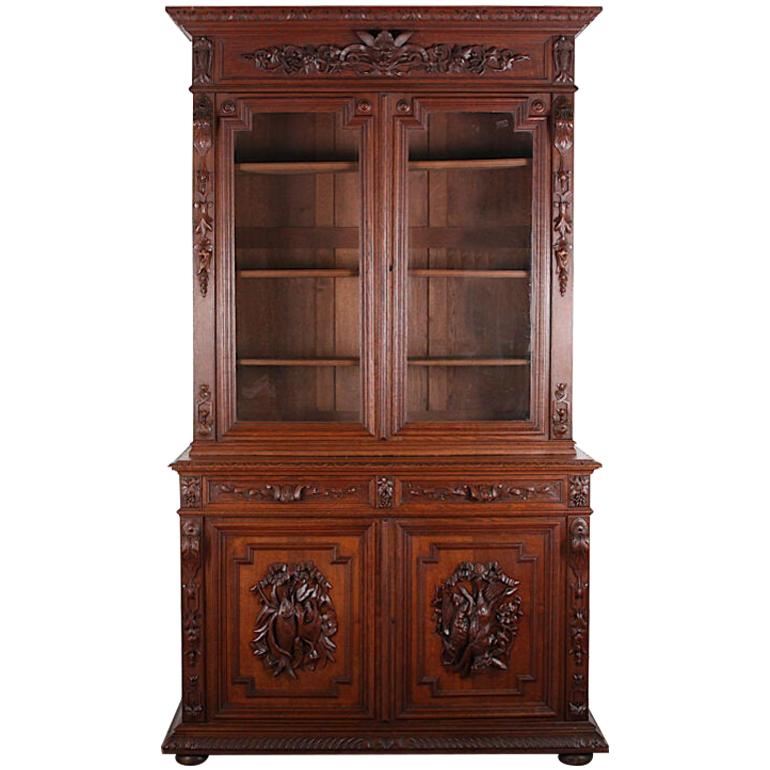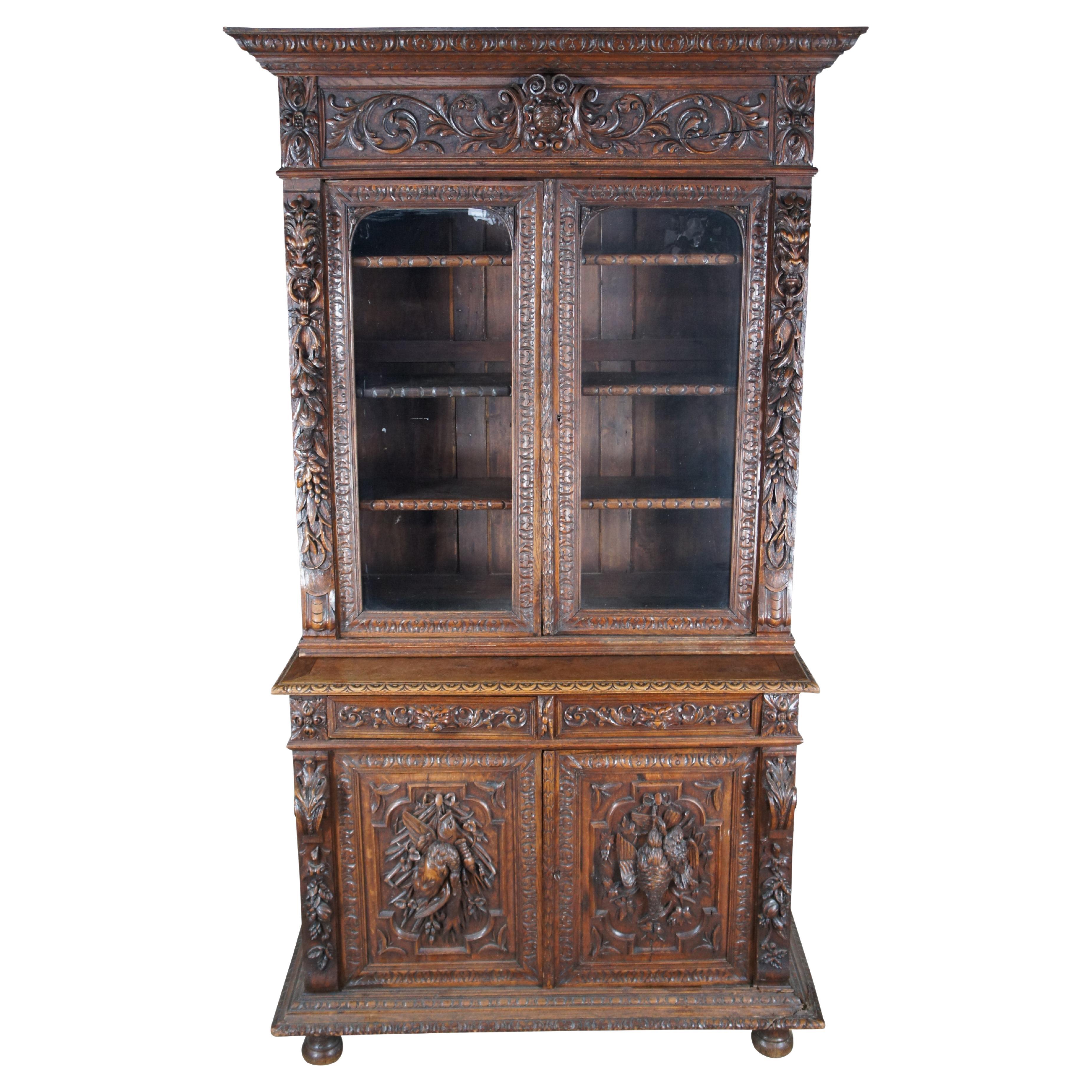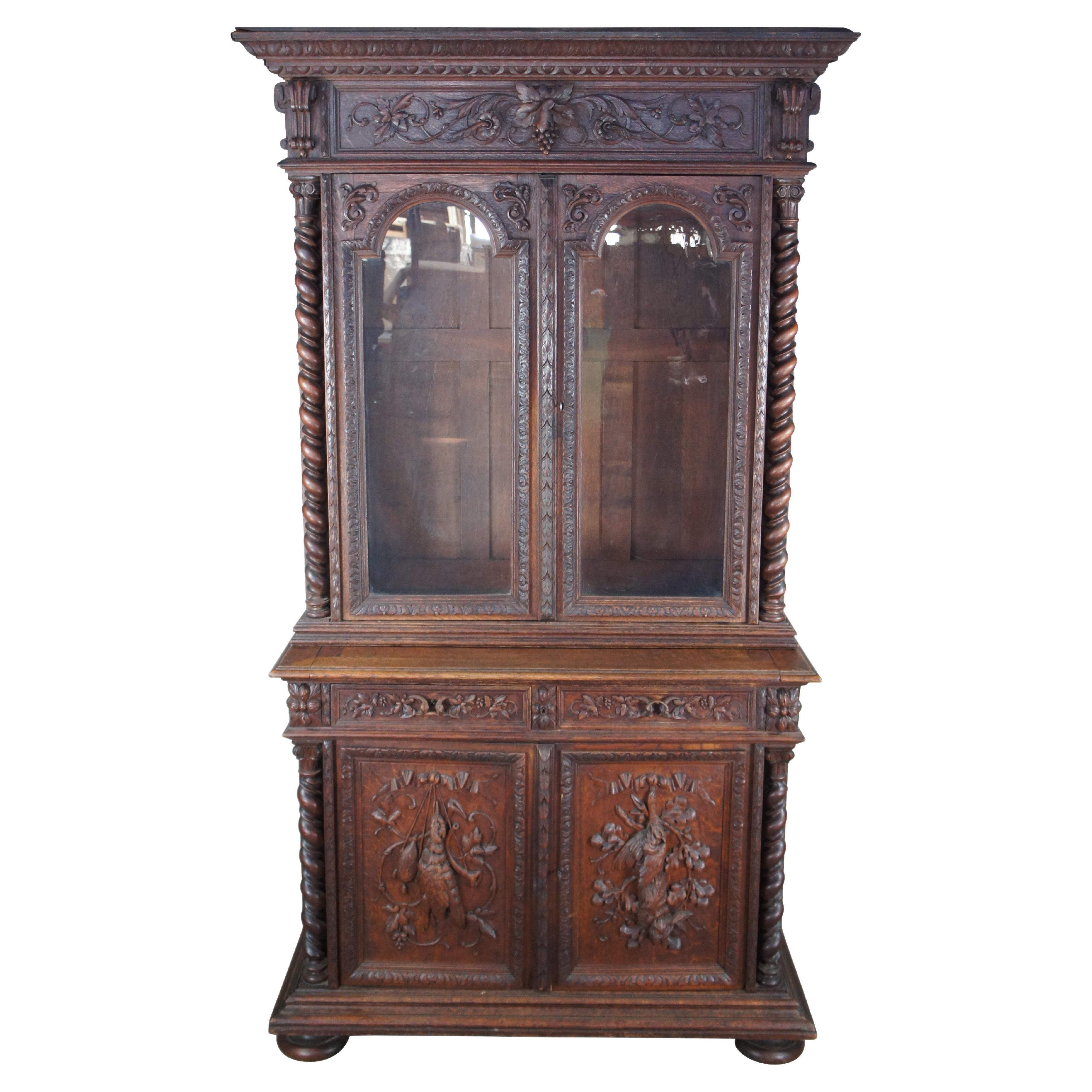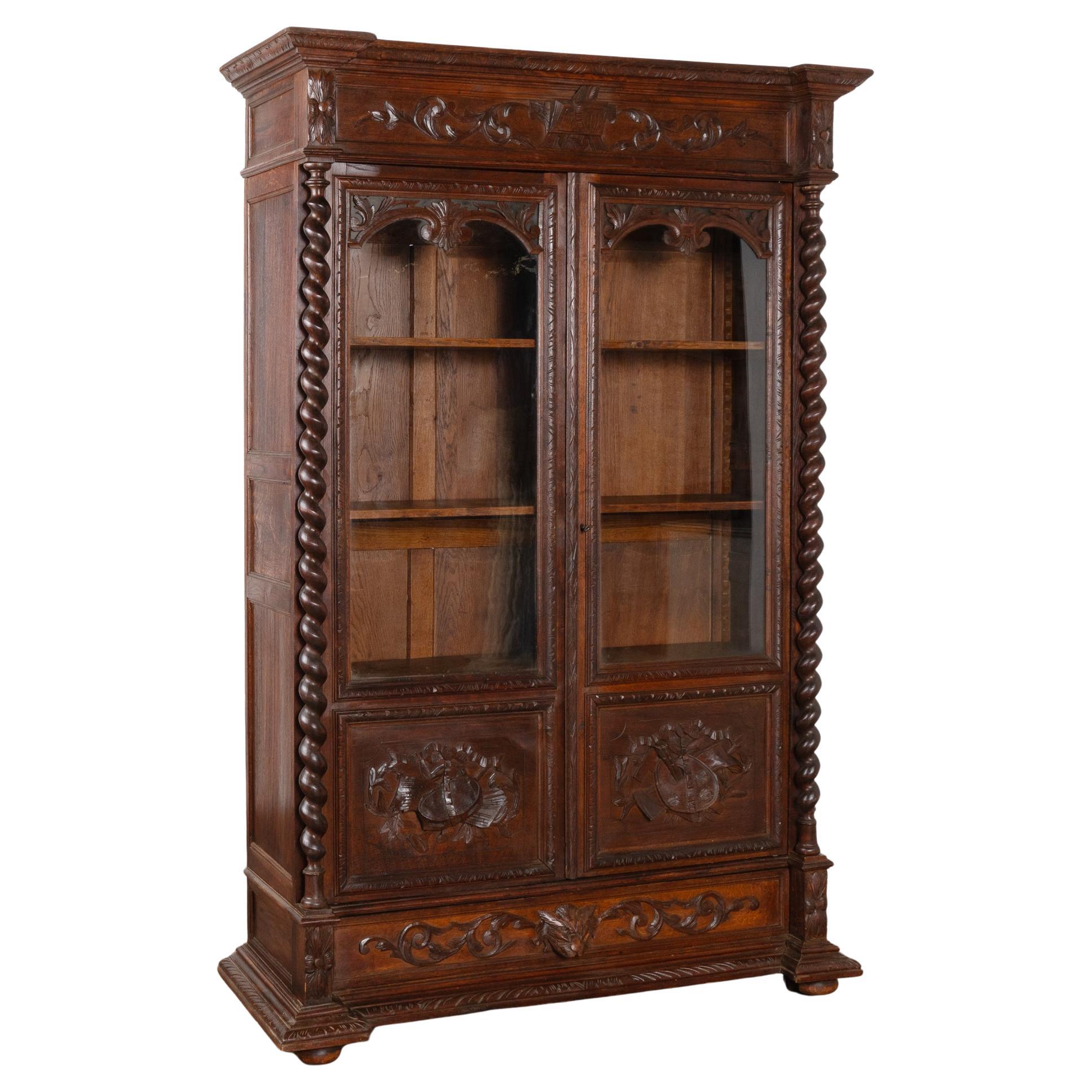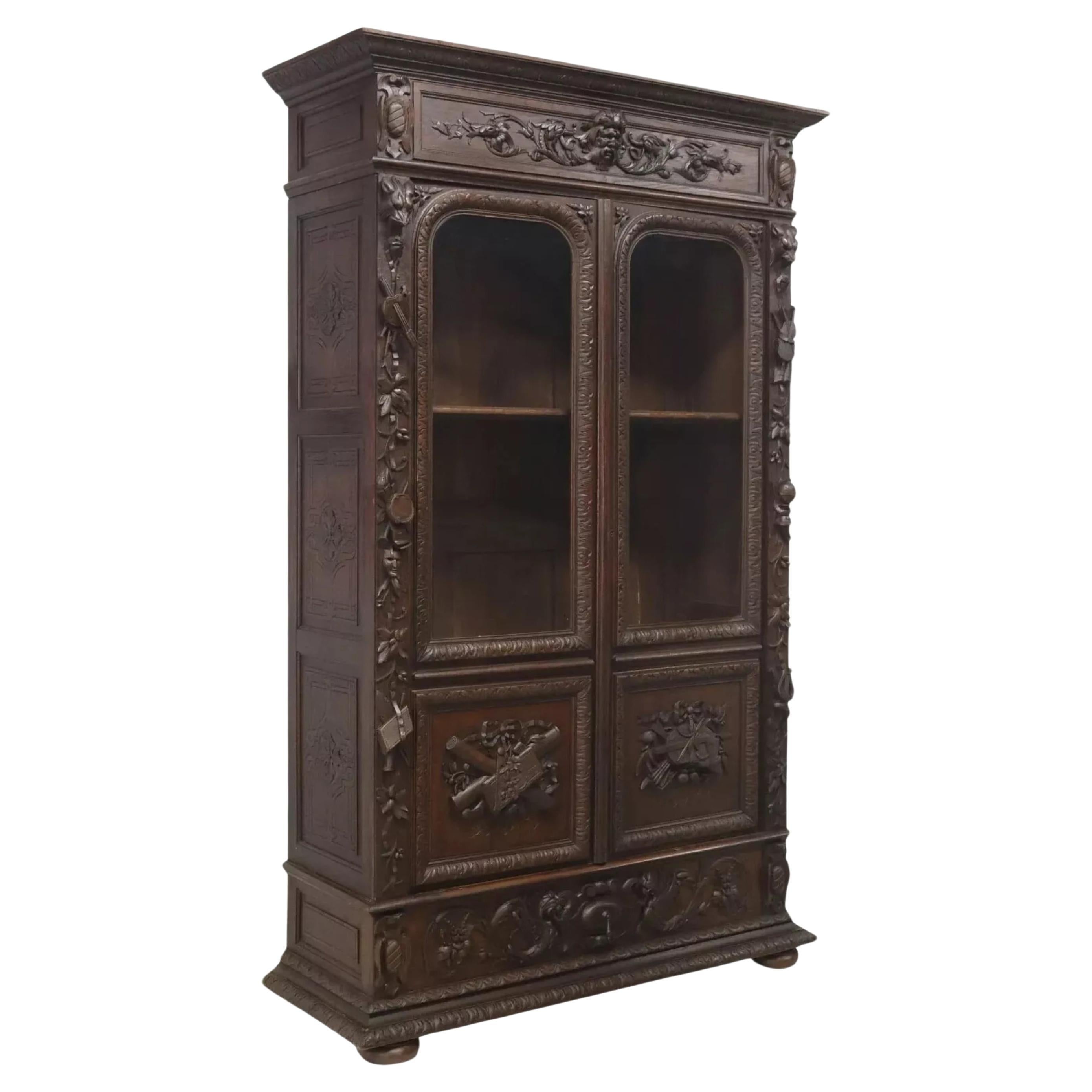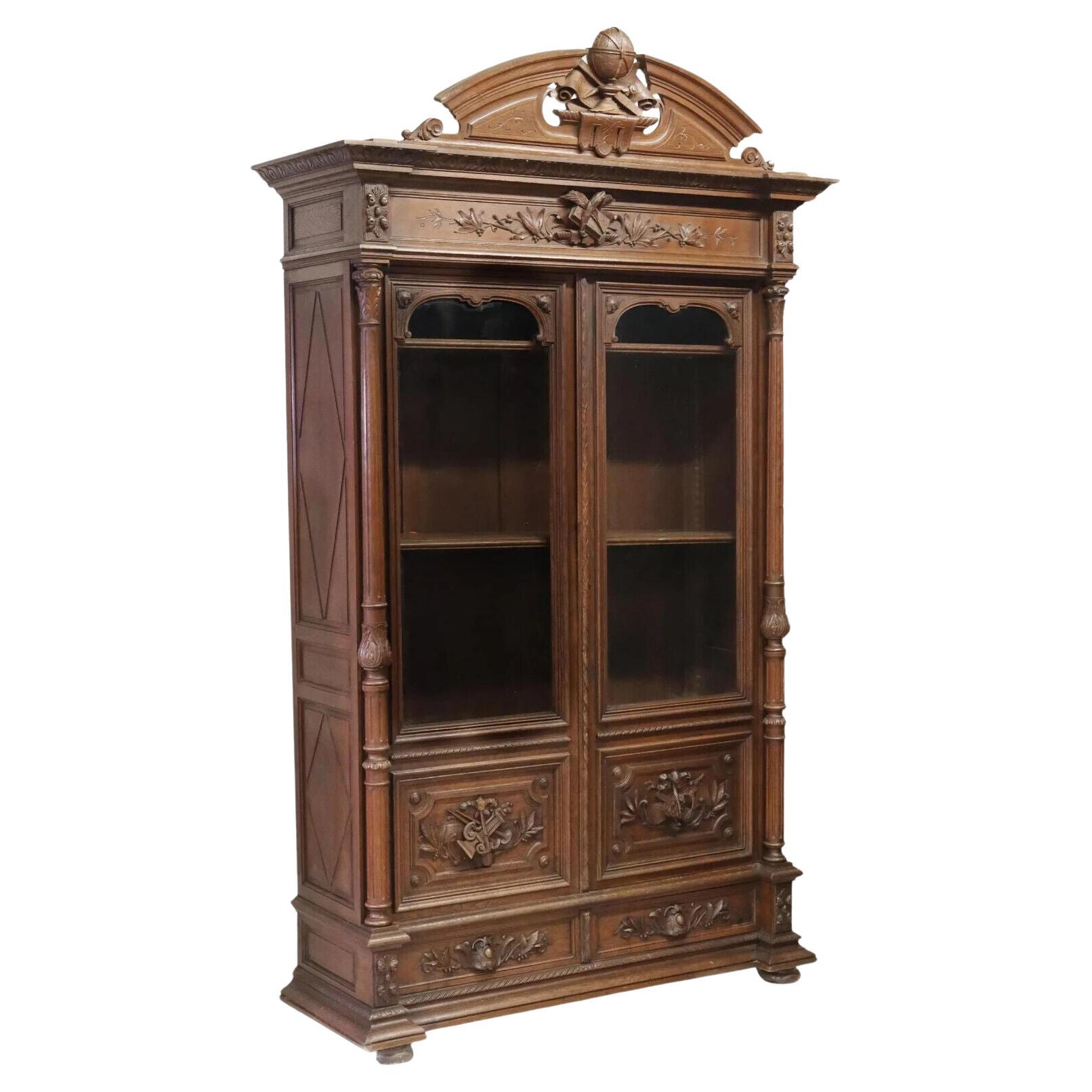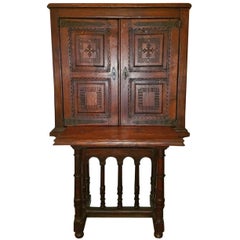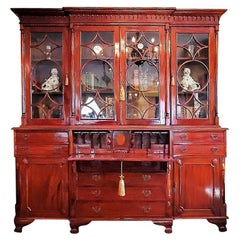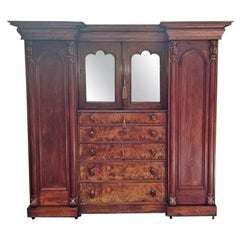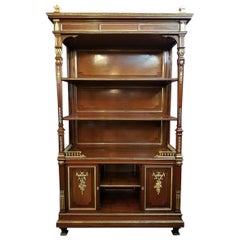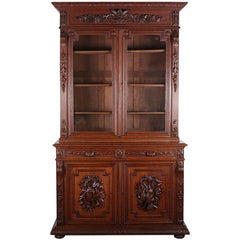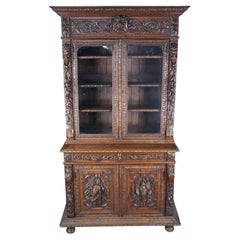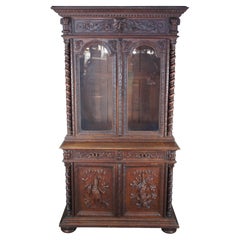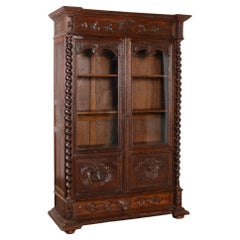Items Similar to 19th Century French Provincial Highly Carved Oak Hunt Bookcase
Want more images or videos?
Request additional images or videos from the seller
1 of 11
19th Century French Provincial Highly Carved Oak Hunt Bookcase
$4,652
£3,532.37
€4,039.53
CA$6,499.52
A$7,228.88
CHF 3,774.70
MX$87,967.82
NOK 48,208.66
SEK 45,211.22
DKK 30,148.58
Shipping
Retrieving quote...The 1stDibs Promise:
Authenticity Guarantee,
Money-Back Guarantee,
24-Hour Cancellation
About the Item
PRESENTING AN ABSOLUTELY GORGEOUS AND IMPOSING Early 19C French Provincial Highly Carved Oak Bookcase.
French Provincial Oak Bookcase from circa 1840.
Heavily carved, this style is often referred to as being in "Hunt Style", from Northern France and often incorrectly, described as Flemish.
Pelmet heavily carved with Armorial Crest.
The upper section consists of a 2 door glass fronted Bookcase and has Gorgeous barley twist columns to the sides, with 3 interior shelves.
The Base has two doors each with exquisite carvings, one with hanging game birds and the other fish. Again with barley twist columns flanking each side. It opens to reveal a single shelf.
The Bookcase and base are separated by carved 2 drawers.
The entire unit sits on bun feet.
Provenance: Bought from a reputable dealer in Ireland.
Condition: Very good original condition. Some minor repairs and brackets on rear to provide extra stability.
Dimensions: 99.5 in High (In total)
The top section/bookcase section is 44.75 in Wide, 51 in High and 15 in deep
The Base section is 38.50 in High, 51 in Wide and 23.5 in Deep
The pelmet is 10.75 in High and 37 in Wide
- Dimensions:Height: 99.5 in (252.73 cm)Width: 51 in (129.54 cm)Depth: 25 in (63.5 cm)
- Style:French Provincial (Of the Period)
- Materials and Techniques:
- Place of Origin:
- Period:
- Date of Manufacture:1840
- Condition:Repaired: One or two minor repairs but nothing significant. Wear consistent with age and use. Minor losses. Minor structural damages. Very good original condition. One or two very minor cracks/repairs with age but nothing significant. Support brackets installed on the rear for extra stability.
- Seller Location:Dallas, TX
- Reference Number:1stDibs: LU3978111866833
About the Seller
4.9
Vetted Professional Seller
Every seller passes strict standards for authenticity and reliability
Established in 2015
1stDibs seller since 2018
390 sales on 1stDibs
Typical response time: 1 hour
- ShippingRetrieving quote...Shipping from: Dallas, TX
- Return Policy
Authenticity Guarantee
In the unlikely event there’s an issue with an item’s authenticity, contact us within 1 year for a full refund. DetailsMoney-Back Guarantee
If your item is not as described, is damaged in transit, or does not arrive, contact us within 7 days for a full refund. Details24-Hour Cancellation
You have a 24-hour grace period in which to reconsider your purchase, with no questions asked.Vetted Professional Sellers
Our world-class sellers must adhere to strict standards for service and quality, maintaining the integrity of our listings.Price-Match Guarantee
If you find that a seller listed the same item for a lower price elsewhere, we’ll match it.Trusted Global Delivery
Our best-in-class carrier network provides specialized shipping options worldwide, including custom delivery.More From This Seller
View AllCarved Spanish Oak Writing Cabinet, Estate of Vincente Blasco Ibanez
Located in Dallas, TX
Presenting an absolutely stunning 16th century carved Spanish oak writing desk and cabinet, with amazing provenance and historical and literary significance.
This desk/cabinet was purchased by a wealthy Dallas family from a French antique auction held at the club room in the Stoneleigh court (hotel), Dallas on Wednesday the 2nd April 1930. (Now the meridian hotel). The auction was titled: “works of art and furnishings of the Chateau de Turique (Nancy) and the Conde-Rougemont home (Touraine). The cover of the catalog also has a seal of a coat of arms. The second page gives a brief description of the auction contents and states that " this exhibition will be presented by M. Fernand M. Adda of Paris France". The desk/cabinet was lot no: 565 and was described in the auction catalog as:
"Carved Spanish writing desk and cabinet...... 16th century period....Upper section a cabinet with two doors which are paneled and display a fine carving. The interior is fitted with eight engraved drawers, and a writing tablet is disclosed in the lower portion. Sustained and central arcade of columns. From Fontana Rosa collection. Supported on four turned legs with bulbous feet."
Fontana Rosa is a historic garden situated on the avenue Blasco Ibáñez in Menton, Alpes-Maritimes, on the French Riviera. The Spanish writer Vicente Blasco Ibanez (1869-1928) began to build it from 1922 on, and he set up home here with his second wife, Elena, and died there in 1928. Vicente Blasco Ibanez was a journalist, politician and best-selling Spanish novelist in various genres whose most widespread and lasting fame in the English-speaking world is from Hollywood films adapted from his works. The provenance is impeccable, it belonged to Ibanez and was part of his collection at Fontana Rosa when he died in 1928.
The auction in which it was first sold in Dallas was in 1930, which makes perfect sense from a 'timeline' point of view. Ibanez is a very important literary figure. Having regard to the fact that this is a writing desk means that in all probability, Ibanez would have 'penned' some of his famous works at this very desk and using the surviving slope/shelf.
Fontana Rosa is a historic garden situated on the Avenue Blasco Ibáñez in Menton, Alpes-Maritimes, on the French Riviera.
The Spanish writer Vicente Blasco Ibáñez (1869-1928) began to build it from 1922 on, and he set up home here with his second wife, Elena, and died there in 1928.
This garden with Spanish and Menton pottery is found in avenue Blasco Ibanez, near Garavan station, and was created a Historical Monument in 1990.
It is also called “Le Jardin des Romanciers” (El Jardín de los Novelistas/The Garden of Novelists), and was frequented by celebrities such as Jean Cocteau. It was the place where Blasco Ibáñez wrote Mare Nostrum, a novel filmed later in 1926.
The garden inspired by Andalusian and Arabian-Persian styles contains species such as Ficus macrophylla, Araucaria heterophylla , palm trees, banana trees or scented rosebushes. It is a tribute to Vicente’s favourite writers : Cervantes, Dickens, Shakespeare or Honoré de Balzac, whose busts can be found at the entrance and to whom he dedicated several fountains and rotundas.
Its main buildings are a small elevated villa with polychromatic pottery which houses a library and a personal movie projector...
Category
Antique 16th Century Spanish Renaissance Cabinets
Materials
Oak
$10,000 Sale Price
20% Off
19C Large Irish Georgian Style Secretary Bookcase
Located in Dallas, TX
PRESENTING a STUNNING 19C Large Irish Georgian Style Secretary Bookcase.
From circa 1850-60 and most definitely, “IRISH”.
Made of gorgeous flamed Cuban mahogany which would have been imported from the British Colonies at the end of the 18th Century and early 19th Century.
This piece of is of IMPRESSIVE PROPORTIONS.
It is a real STATEMENT piece and of EXTREMELY HIGH QUALITY.
It has a very ‘Regency Style’ pelmet or crown with egg and dart moldings under a very straight line crown.
The top section consists of a 4 door bookcase, each with 3 shelving areas. It appears to retain it’s original glass, but it could likewise have been replaced at some time during it’s long life, as it is very rare to find pieces that have not suffered breakages over 150+ years.
Each bookcase door still retains the original moldings to the front with a star shape above and below a central circular viewing panel.
Each section is separated by a carved and fluted roman column/pillar.
The bookcase section rests on top of the base, which consists of a beautiful central secretaire desk accessed by drop down front with working lock and key and rests on 2 pull out rests on either side. The secretary portion has a central tabernacle, with an inlaid oval satinwood medallion above another scallop shell drawer. It has 6 smaller drawers and 8 cubbies. The 2 pillars on either side of the central tabernacle are secret drawers and pull out. The curved crowns above the cubbies on either side are likewise secret drawers and pull out.
Either side of the secretary there are 2 drawers (4 total) with a press or cupboard underneath.
Under the secretary there are 4 large central drawers.
The brasses and hardware are all original to the piece (save 2 extra hinges that have been attached to the drop down secretary to give it more support and stability.
Again, each section is separated by a turned and fluted column/pillar which replicates the 2 side pillars to the central tabernacle of the secretary.
The piece sits on 8 curved feet.
This was an extremely high quality piece when made. This is also supported by the fact that the secondary woods are also mahogany and not pine or oak for slightly lesser quality pieces of the era.
This piece is specifically identifiable as an Irish Georgian Style piece by virtue of the scallop shell moldings on the base side presses (see photos).
Irish Georgian furniture...
Category
Antique Mid-19th Century Irish George III Bookcases
Materials
Glass, Mahogany, Satinwood
Early 19th Century British Mahogany Gothic Revival Wardrobe
Located in Dallas, TX
Beautiful early 19th century, circa 1830, William IV Period, mahogany Regency Gothic Revival wardrobe or armoire or linen press with central mirrored tabernacle and 5-drawer chest of...
Category
Antique Early 19th Century English William IV Wardrobes and Armoires
Materials
Mahogany
$3,600 Sale Price
47% Off
Rare 19C Portois & Fix Viennese Cabinet
By Portois & Fix
Located in Dallas, TX
PRESENTING A STUNNING and RARE 19C Portois & Fix Viennese Cabinet.
Made by the famous and highly desirable maker, ‘Portois & Fix’ in Vienna, Austria ...
Category
Antique Late 19th Century Austrian Belle Époque Cabinets
Materials
Brass, Ormolu
$20,800 Sale Price
46% Off
Large 19 Century French Rococo or Neoclassical Revival Style Vitrine
By David Roentgen
Located in Dallas, TX
Stunning 19th century French Empire, neoclassical/Rococo Revival style Marquetry vitrine or display cabinet, of large proportions!!
A real statement piece!
Made of a fabulous variety of veneers, including kingwood, satinwood, tulipwood, harewood and walnut with quality classical ormolu mounts.
It has ebonized pillars in the Empire style, with walnut and exotic hardwood friezes in the Rococo style.
Double glass doors to middle section and single glass doors on either side.
The glass on the doors are framed in ormolu banding.
Floral Marquetry panels on front and parquetry on the sides.
The front central section is a pullout / pull-out drawers with gorgeous walnut frieze panel and original carved walnut knobs.
Scrolling pelmet on the top in 3 sections banded in ormolu beading.
Scrolling base with cabriolet feet and ormolu mounts on base.
Various ormolu mounts, floral mounts, mounts of Baachus and mounts of neoclassical female figures.
In 3 sections. with 2 side cabinets and large central section with 3 section pelmet, stunning piece!!!
The quality ormolu mounts are marked with the letter “R” and what appears to be “FR 678”.
We were originally of the belief that this piece might have been made at the very end of the 19th century, but having regard to the quality of workmanship throughout this piece we are of the opinion that it was most likely made in the third quarter of the 19th century, circa 1870 and by an obviously top quality Parisienne maker with a surname beginning with “R”.
It is definitely in the style of David Roentgen who was known for his Rococo/neoclassical styles.
David Roentgen, (born Aug. 11, 1743-died Feb. 12, 1807, Wiesbaden, Duchy of Nassau), cabinetmaker to Queen Marie-Antoinette of France; under his direction the family workshop at Neuwied (near Cologne), founded by his father, Abraham Roentgen, became perhaps the most-successful firm of furniture production in the 18th century.
After succeeding his father as head of the Neuwied workshop in 1772, Roentgen strove to broaden their clientele, an ambition that brought him first to Hamburg and ultimately to Paris (1774), where in 1779 he was spectacularly successful in selling his finest furniture to King Louis XVI of France for £3,300 to £4,000, an unprecedented sum for the time.
Appointed cabinetmaker to the queen, Roentgen was granted admission (1780) as maître-ébéniste (master cabinetmaker) to the trade corporation of Paris cabinetmakers, making it possible for him to keep in Paris a stock of the furniture manufactured at Neuwied. Thus he was able to compete with such great cabinetmakers as Jean-Henri Riesener and Adam Weisweiler, reputedly his former pupil at Neuwied. After his first visit to St. Petersburg, Empress Catherine II the Great bought huge quantities of his furniture; King Frederick William II of Prussia was also his client. When in 1795 the French Revolutionary armies threatened to cross the Rhine, Roentgen evacuated his establishment and moved his stock farther inland. Unfortunately, he lost everything in his Parisian salon and in his Neuwied workshop, both of which were sacked by Republican troops. He was crushed, despite his appointment as court furnisher to the king of Prussia. Although he never succeeded in starting production again, former apprentices of his whom he helped to establish in the German cities of Berlin (David Hacker...
Category
Antique Mid-19th Century French Rococo Revival Vitrines
Materials
Ormolu
$9,600 Sale Price
48% Off
19C English Marquetry Inlaid Corner Cabinet Attributed to Collinson and Lock
By Collinson & Lock
Located in Dallas, TX
PRESENTING A GORGEOUS late 19th Century British made corner cabinet, made of beautiful rosewood and profusely inlaid with marquetry and faux ivory.
Made in London, by Collinson and ...
Category
Antique Late 19th Century English High Victorian Corner Cupboards
Materials
Bone, Ebony, Rosewood, Satinwood
$4,860 Sale Price
59% Off
You May Also Like
19th Century French Carved Oak Renaissance Revival Hunt Bookcase Cabinet
Located in Vancouver, British Columbia
Impressive French carved oak Renaissance-revival bookcase with finely-carve ‘hunt’ motifs to the lower doors below carved drawers, the top with a pair of glass doors...
Category
Antique Late 19th Century French Renaissance Revival Bookcases
Materials
Oak
Antique French Renaissance Revival Oak Carved Hunt Bookcase Display Cabinet 97"
Located in Dayton, OH
Exceptional Antique 19th Century Renaissance Revival Hunt Cabinet. Hand carved from oak with a large upper display portion that opens to three adjustable shelves. Door frames are neatly carved and flanked by meticulously carved outer stiles with figural ringed lion spandrels over a fruit and foliate motif. Crown is centered by a shell and scrolled foliate cartouche set between acanthus motif and French medallions.
The base of the cabinet has two hand dovetailed drawers with figural carved gargoyle...
Category
Antique 19th Century Renaissance Cabinets
Materials
Glass, Oak
$4,800 Sale Price
20% Off
Antique 19th Century French Henry II Carved Oak Hunt Cabinet Bookcase Cupboard
Located in Dayton, OH
Exceptional Antique 19th Century French Henry II / Renaissance Revival Hunt Cabinet. Hand carved from oak with a large upper display portion flanked by barley twisted columns. Opens ...
Category
Antique 19th Century Renaissance Revival Cabinets
Materials
Oak
$4,000 Sale Price
20% Off
Tall Carved Oak Bookcase Display Cabinet, Germany circa 1880-1890
Located in Round Top, TX
Impressive Oak Renaissance Revival bookcase heavily carved with 2 glass doors and adjustable shelves.
Barley twist columns, carved embellishments along crown, drawer, panels and thro...
Category
Antique Late 19th Century German Renaissance Revival Bookcases
Materials
Glass, Oak
1800's Antique Library, French Renaissance Revival, Carved Oak Bookcase!
Located in Austin, TX
Stunning 1800's Antique Library, French Renaissance Revival, Carved Oak Bookcase!
Antique Bookcase, Library, French Renaissance Revival, Carved Oak, 1800s, 19th Century!
This antique bookcase is a true gem for any collector or lover of French Renaissance architecture...
Category
Antique 19th Century French Renaissance Revival Bookcases
Materials
Oak
1800's Antique Library, French, Carved Oak, Glazed Doors Bookcase!
Located in Austin, TX
Exceptional Antique Bookcase , Italian Renaissance Revival, Foliates, Late 19th Century, 1800s, 19th Century!!
This exquisite antique bookcase features exceptional craftsmanship and...
Category
Antique 19th Century Italian Renaissance Revival Bookcases
Materials
Wood, Oak
$2,450 Sale Price
24% Off
More Ways To Browse
Mid Century French Provincial
Used Oak Bookcase
Antique Oak Carved Cabinet 19th Century
Oak Carved Column
Cased Fish
French Carved Bird
Oak Bookcase With Doors
Heavily Carved Oak
19th Century French Bookcase
Glass Front Bookcase
French Hunt Furniture
French Bookcase Oak
Open Bookcase French
Oak Bookcase Glass Door
Carved Oak Bookcase
Glass Door Bookcase French
Bird Carved Cabinet
French Carved Bookcase
